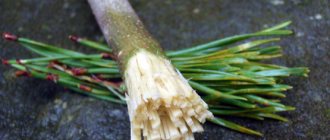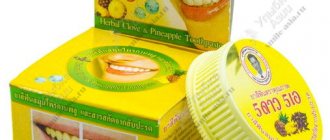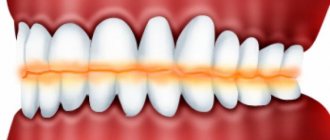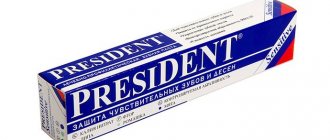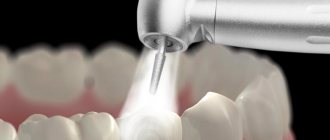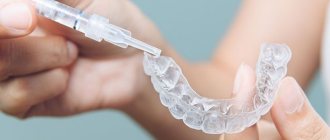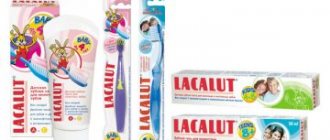Late diagnosis and treatment of periodontal tissue diseases can lead to tooth loss! Self-medication does not work! Contact PerioCenter specialists!
- 044 337-93-60
Gum disease is a very common phenomenon in dentistry, which very often receives completely undeservedly little attention. As a rule, people are more concerned about the condition of their teeth. On hard tissues, any even minor change is detected earlier. People usually treat the gums, ligaments and bone that surround the tooth when the pathological process is already in a fairly advanced state. Inadequate self-medication plays an important role in such a situation. In the case of inflammation of soft tissues, the patient usually tries all the methods of traditional medicine before seeking qualified help and sometimes, without understanding it, manages to aggravate the situation with these actions. Toothpaste for periodontal disease is no exception in this situation if its choice is not correct.
Periodontal disease is a disease that is often genetically determined and is associated with changes in the walls of blood vessels that supply bone and soft tissue. Much more common is periodontitis - inflammation of the gums caused by specific pathogenic microorganisms against the background of poor oral hygiene. However, high-quality teeth cleaning will help alleviate the severity of the disease and speed up the treatment of any diseases of the gums and surrounding tissues. Therefore, after treatment procedures, the doctor gives recommendations on hygienic care. One of the common questions is “which toothpaste is best for teeth and gums for periodontal disease?” It’s quite difficult to make such a choice, since stores and pharmacies have a very large selection of toothpastes, and advertising promises all sorts of impossible effects.
How to choose toothpaste for periodontal disease
The toothpaste for periodontal disease that we need belongs to the class of therapeutic and prophylactic with an anti-inflammatory effect. They are not suitable for permanent use. Some of them contain antiseptics. To prevent microflora from developing addiction, it is necessary to refrain from using them for some time.
Let’s look at the question: “which is the best anti-inflammatory toothpaste for periodontal disease.”
Types of anti-inflammatory pastes (depending on the active ingredient:
- Pastes containing aluminum lactate;
- Pastes with antiseptics: triclosan, hexitidine, chlorhexidine, biosol;
- Salt;
- Chlorophyll-containing;
- Containing enzymes;
- With herbal extracts.
There are good reviews about the antimicrobial effects of pastes containing triclosan. Triclosan is active against not only bacteria, but also fungi, yeast and viruses.
A medicinal toothpaste for periodontal disease should not contain all of the above components; even one is sufficient. Before you buy a paste, it is advisable to understand exactly what symptoms it will fight. If you are very concerned about bleeding, then aluminum lactate should be a mandatory component of the toothpaste. Aluminum lactate has astringent properties and bleeding may decrease even after the first application. Extracts of some herbs, such as oak bark, have the same effect. If it is first necessary to eliminate inflammatory symptoms, then preference should be given to pastes with antiseptics and salt compounds. Antiseptics destroy microflora that causes inflammation, and salt compounds help reduce swelling.
Salt pastes. The inflammatory fluid accumulated in the soft tissues and periodontal pockets moves towards a higher concentration of salts, a hypertonic environment.
It is very good when the paste contains a combination of anti-inflammatory and hemostatic components. Please note that if the composition contains triclosan, chlorhexidine or another antibacterial drug, then such pastes cannot be used for more than two weeks, otherwise the pathogenic microflora will become addictive and conditions will be created for the occurrence of fungal diseases.
Chlorophyll-containing toothpaste for the treatment of periodontal disease is good during the recovery stage. Chlorophyll promotes epithelialization of lesions and accelerates gum healing. Enzymes are not the most important component in toothpaste, but they can significantly accelerate the course of inflammation by breaking down toxins produced by bacteria and dead tissue, and also reduces vascular permeability. Enzymes are of plant origin.
It is very difficult to influence the inflammatory process in tissues due to any one component. The effectiveness of the paste is determined by the optimal combination of several components
Clinical researches
It has been clinically proven that the use of Asepta products helps reduce complaints of discomfort in the oral cavity and heal tissue. On the 7th day, complaints of bleeding gums went away in most patients. Upon examination, a decrease in hyperemia and swelling of the gums was noted, but bleeding persisted upon probing. On the 14th day, most patients had no complaints about bleeding gums when brushing their teeth; upon examination, a significant decrease in hyperemia and swelling of the gums was noted.
Improved dynamics of indicators allows us to recommend the Asepta line of products for local treatment and prevention of inflammatory periodontal diseases.
Sources:
- Clinical experience in using the Asepta series of products Fuchs Elena Ivanovna Assistant of the Department of Therapeutic and Pediatric Dentistry State Budgetary Educational Institution of Higher Professional Education Ryazan State Medical University named after Academician I.P. Pavlova of the Ministry of Health and Social Development of the Russian Federation (GBOU VPO RyazSMU Ministry of Health and Social Development of Russia)
- The use of drugs from the Asepta line in the complex treatment of inflammatory periodontal diseases (N.V. Berezina E.N. Silantyeva S.M. Krivonos, Kazan State Medical Academy. Kazan.) N.V. BEREZINA, E.N. SILANTIEVA, S.M. KRIVONOS Kazan State Medical Academy
- The use of adhesive balm "Asepta®" in the treatment of inflammatory periodontal diseases L.Yu. OREKHOVA*, Dr. med. Sciences, Professor, Head of Department V.V. CHPP**, Dr. med. Sciences, Professor, Head of Department S.B. ULITOVSKY*, Dr. med. Sciences, Professor A.A. LEONTIEV*, dentist A.A. DOMORAD**, O.M. YAKOVLEV** SPbSMU named after. acad. I.P. Pavlova, St. Petersburg - *Department of Therapeutic Dentistry, **Department of Microbiology
- Study of the clinical effectiveness of treatment and prophylactic agents of the Asepta line in the treatment of inflammatory periodontal diseases (A.I. Grudyanov, I.Yu. Aleksandrovskaya, V.Yu. Korzunina) A.I. GRUDYANOV, Doctor of Medical Sciences, Prof., Head of Department I.Yu. ALEXANDROVSKAYA, Ph.D. V.Yu. KORZUNINA, asp. Department of Periodontology, Central Research Institute of Dentistry and Maxillofacial Surgery, Rosmedtekhnologii, Moscow
- Report on clinical trials of anti-inflammatory balm for gums "Asepta" adhesive, St. Petersburg State Medical University, 2007
Examples of toothpastes for periodontal disease
Which toothpaste to choose for periodontal disease? Here are some well-known examples.
“Lakalut-active” is a fairly popular and advertised toothpaste against periodontal disease. The main components in it are aluminum lactate, chlorhexidine, allantoin and bisabolol. Aluminum lactate reduces bleeding due to its astringent properties, chlorhexidine neutralizes pathogens, and allantoin and bisabolol eliminate symptoms of inflammation. Well suited for exacerbation of periodontitis and bleeding due to periodontal disease. Please note right away that due to chlorhexidine, it cannot be used for longer than 2 weeks.
Late diagnosis and treatment of periodontal tissue diseases can lead to tooth loss! Self-medication does not work! Contact PerioCenter specialists!
- 044 337-93-60
"Paradontax" is a well-known toothpaste, its name speaks for itself. Contains several extracts of medicinal herbs (echinacea, chamomile, sage, ratania) and mineral salts. The total anti-inflammatory effect of herbal extracts and salts allows you to quickly and harmlessly remove gum inflammation. The concentration of herbs is quite high; herbs with an astringent and antimicrobial effect are combined. Does not contain antiseptics, so its use is not limited. The composition contains zinc zither, which reduces tooth sensitivity, which is very important for periodontal disease and wedge-shaped defects. It is characterized by a salty taste. You have to get used to this specific taste. Available in two versions: without fluorine and with fluorine. The second option is preferable, since in addition to treating gums, caries can be prevented.
Toothpaste “President-exclusive” This toothpaste contains propolis, hexitidine, and thyme. Hexitidine is a powerful antiseptic that affects the main cause of inflammation - bacteria. Propolis is a beekeeping product that has antimicrobial and anti-inflammatory effects. Thyme or thyme is a plant from the family.
Lamiaceae, contains thymol, which is an antiseptic and analgesic. This toothpaste helps well with acute processes, hemostatic, i.e. the hemostatic effect is less pronounced.
"Forest Balsam" This toothpaste contains a combination of herbal extracts, mainly astringent: oak bark, fir, chamomile, St. John's wort, yarrow and nettle. The main effect is the elimination of bleeding.
It's up to you to decide which is the best toothpaste for periodontal disease.
Periodontal disease is...
A disease such as periodontal disease, which affects the periodontal tissue (periodontium), is quite rare - in 1 - 8% of patients visiting dental clinics. However, for those who experience it, it can cause a lot of problems, both physical and emotional. The main difficulty in treating this disease is that diagnosing the disease at the beginning of its progression is very difficult, if not impossible.
Periodontal disease is characterized by gradual atrophy of the dental canals, reduction in the size of the interdental septa, which precedes the loosening and loss of teeth.
With this disease, a burning sensation, itching and pulsation in the gums are clearly felt in the oral cavity, they bleed every time you brush your teeth, there is a repulsive odor from the mouth, and painful sensations when chewing food while eating.
Let's sum it up
Pastes for the treatment of gum disease only eliminate some signs of inflammation. If the cause of periodontitis and periodontal disease is tartar, areas of over-occlusion, or any specific type of infection, the disease will not go away. The use of medicinal pastes and self-medication will only blur the clinical picture of the disease and complicate the diagnosis.
The negative point in using such products is that they can mask serious gum diseases, removing symptoms such as redness and swelling. As a result of this use, a person goes to the dentist only at that stage of the disease when the teeth become mobile. You should not fight bleeding gums for a long time only with the help of pastes. When you go to the dentist, treatment may be limited to just removing tartar. No toothpaste will help you treat your gums if you brush your teeth incorrectly and use a low-quality toothbrush. If your gums bleed and hurt when brushing, use a brush with soft bristles, which will make the procedure more comfortable.
Pay attention to the composition of toothpastes; if they contain antiseptics, they should not be used for more than two weeks. Otherwise, dysbacteriosis will occur, against which the fungus grows very well. After completing the cleaning, it is advisable to hold the cleaning solution in the oral cavity for 1-2 minutes and prolong the effect of the active components on the inflamed tissues.
The most popular toothpastes that do not contain fluoride
Consumer reviews and expert advice helped us create a rating of fluoride-free toothpastes.
Paradontox
- produced by the Glaxo Smih Klin group of companies (Slovakia);
- active ingredients: sodium bicarbonate (soda), mineral salts;
- cost 170-200 rubles.
Paradontax toothpaste without fluoride has a salty taste and an unusual color (pink-brown), which is due to its natural composition: it contains extracts of sage, mint, myrrh, chamomile, echinacea, and ratania. Dentists recommend using it for people with bleeding gums and for the treatment of stomatitis.
Advantages:
foams well, removes plaque, effectively fights periodontal disease.
Flaws:
It has a unique taste that takes some time to get used to.
President Unique
- produced by the Italian company Betafarma SPA;
- contains: calcium lactate, calcium pantothenate, calcium glyceroformate;
- cost: from 180 to 250 rubles.
In addition to 3 active components containing calcium, this paste contains the enzyme papain, which easily destroys and removes plaque, and xylitol, which neutralizes the acidic environment in the oral cavity. Recommended for the prevention of caries and inflammatory processes in the oral cavity.
Advantages:
protects against caries and sensitivity of tooth enamel, prevents inflammation of the gums, enhances the shine of the enamel.
Flaws:
It is not recommended for daily use, since the pain-relieving additives contained in its composition do not allow timely diagnosis of caries.
Neobio
- manufactured by Neobio (Germany);
- active substance: calcium carbonate;
- cost: 150-200 rub.
Neobio fluoride-free toothpaste does not contain chemical components; silicic acid is used as an abrasive and carrageenan from seaweed is used as a thickener. It contains herbal components that protect against gum inflammation: witch hazel, rosemary, chamomile, sage, myrrh, peppermint oil.
Advantages:
a natural product that effectively removes plaque and protects against gum inflammation, has a pleasant taste, and freshens breath well and for a long time.
Flaws:
not noticed.
ROCS 1 Calcum
- made in Russia;
- active ingredients: calcium glycerophosphate, magnesium chloride, bromelain;
- cost 230-250 rub.
Active components protect the oral cavity from harmful microorganisms, protect the enamel from destruction by increasing its acid resistance, normalize the microflora and prevent plaque from forming on the teeth during the day.
Advantages:
can be used if the enamel is overly sensitive, since it does not contain abrasive substances;
Flaws:
cost, liquid consistency.

